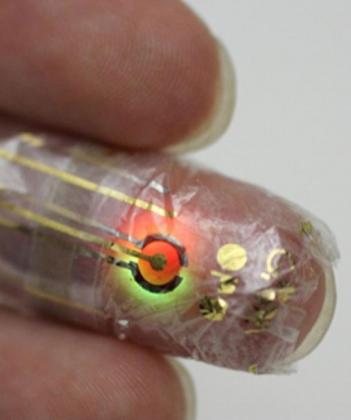
Writing in the journal Science Advances, scientists from the University of Tokyo describe how they made their prototype “e-skin” from a thin, flexible, organic material that is stable in air.
The e-skin has a protective film comprising five alternating layers of an inorganic material called silicon oxynitrite and an organic material called parylene. This protects the onboard electronics from water vapor and air, extending device lifetimes from the few hours achieved in previous designs to days.
In their paper, the researchers describe incorporating transparent electrodes into the film without damaging it. Once this was achieved, they then created polymer light-emitting diodes (PLEDs) and organic photodetectors using the material.
Next, they devised a blood oxygen level monitor that is worn on the finger. Red and green PLEDs shine light into the finger, and the reflected light from inside the finger is caught by a photodetector, providing a measure of blood oxygen and pulse rate, which can be displayed as a reading on a PLED display.
Wearable technology that monitors body functions is a growing area of biomedical research. However, there are many challenges to overcome, including the development of suitable materials that are thin and flexible enough so they attach to and remain on the body and can be worn comfortably and unobtrusively.
The glass or plastic materials that have been developed so far have either been too thick – on the scale of millimeters – or not flexible enough. And while organic materials reach suitable micrometer-scale thinness and flexibility, they degrade quickly in air.
Material enables ‘e-skins with multiple electronic functionalities’
The e-skin that senior author Takao Someya, a professor at Tokyo’s Graduate School of Engineering, and colleagues have developed appears to overcome many of the problems of previous designs. It enables the creation of ultra-thin and ultra-flexible electronic devices that remain stable in air for several days. The authors note:
“In combination with an engineered elastomeric substrate, such devices become highly stretchable and repeatedly sustain up to 60% compression. Such extremes in flexibility, weight, and stretchability allowed the realization of e-skins with multiple electronic functionalities, such as sensors and displays, which can be worn on the surface of human skin.”
The PLEDs that the team created were only 3 micrometers thick and their efficiency was six times greater than that of previously reported ultra-thin PLEDs. This means they require far less power and produce a lot less heat – making them particularly suitable for attaching directly onto the body.
The following video shows how PLEDs in e-skin worn on the hand could display a meaningful reading:
The researchers hope their e-skin will lead to the creation of devices that measure and display not only blood oxygen and pulse rate but other vital functions. They also suggest that:
“Ultimately, flexible organic optical sensors may be directly laminated on organs to monitor the blood oxygen level during and after surgery.”
E-skin technology could also have applications outside medicine, such as athletics, personal fitness and communications. Prof. Someya suggests e-skin technology could transform personal communications to the same extent as mobile phones have. He notes:
“The advent of mobile phones has changed the way we communicate. While these communication tools are getting smaller and smaller, they are still discrete devices that we have to carry with us. What would the world be like if we had displays that could adhere to our bodies and even show our emotions or level of stress or unease?”
In January, Medical News Today also learned about the development of a smart contact lens that could predict glaucoma progression.
[Source:- MNT]



